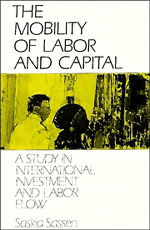Book contents
- Frontmatter
- Contents
- List of tables
- Acknowledgements
- Introduction
- 1 Foreign investment: a neglected variable
- 2 The use of foreign workers
- 3 The new immigration
- 4 The globalization of production: implications for labor migration
- 5 The rise of global cities and the new labor demand
- 6 The reconcentration of capital in the United States: a new investment zone?
- Conclusion
- Notes
- References
- Index
2 - The use of foreign workers
Published online by Cambridge University Press: 04 April 2011
- Frontmatter
- Contents
- List of tables
- Acknowledgements
- Introduction
- 1 Foreign investment: a neglected variable
- 2 The use of foreign workers
- 3 The new immigration
- 4 The globalization of production: implications for labor migration
- 5 The rise of global cities and the new labor demand
- 6 The reconcentration of capital in the United States: a new investment zone?
- Conclusion
- Notes
- References
- Index
Summary
The use of foreign labor, whether slaves or immigrants, has been a basic tendency in the development of industrial economies. In most accounts of capitalist development, the struggle by employers to recruit and maintain an adequate labor supply has been overshadowed by the problems of realization, most particularly, market expansion. However, a central precondition for the realization of the surplus-generating possibilities of a geographic location is the formation of a politically and economically suitable labor supply. In the study of centrally planned economies, the securing of an adequate labor supply has been more prominent than in that of free market economies.
This chapter has a dual purpose. First, to document how past and present dynamic growth situations tend to require drawing on “foreign” labor supplies. This is significant because today, at a time of growing unemployment, the general belief is that labor is always in surplus. In fact, labor shortages and the need to bring in workers from other areas have been common features in several recent high-growth situations, such as the post World War II reconstruction in Western Europe, the vast industrialization programs in OPEC members after 1973, and the U.S. Sunbelt region in the mid-1970s. Furthermore, socialist economies also experience labor shortages in growth areas and have relied on various types of foreign labor, e.g., Algerian migrant workers in East Germany and Finns in the Soviet Union.
- Type
- Chapter
- Information
- The Mobility of Labor and CapitalA Study in International Investment and Labor Flow, pp. 26 - 54Publisher: Cambridge University PressPrint publication year: 1988



